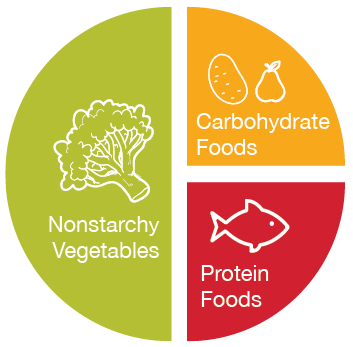The Diabetes Plate Method: How to Build a Healthy Plate Without Counting Carbs
October 24, 2022
For many with diabetes, dining out can be a difficult experience when trying to manage blood sugar levels, but it doesn’t have to be. You just have to be a little creative and remember the basic principles from the American Diabetes Association’s (ADA) Diabetes Plate Method. According to the ADA, this method can be used as a quick and easy way to create diabetes-friendly meals—whether at home or dining out at your favorite restaurant. We spoke to Overlake Registered Dietitian Nutritionist Tianyue Zhao, MS, RDN, to learn more.

Here’s a quick overview of the ADA’s Diabetes Plate Method:
- Fill half of your plate with nonstarchy vegetables.
- Fill one quarter of your plate with protein.
- Fill one quarter of your plate with carbohydrates (beans and legumes, starchy vegetables, grains, etc.).
Now, it’s time to be creative! Here’s what to do…
- Actively think about ways to complete your plate using the three different food groups: vegetables, protein and carbohydrates.
- Try to order meals that include all three food groups or order side dishes that include the food group that is missing from the entrée.
- You may need to order a separate item and that’s OK. For example, if you go out for pizza, consider adding a side salad or extra veggie toppings. The pizza crust is a carbohydrate, cheese and meat are proteins, so the only food group missing is vegetables.
- Portion control matters.
- Meals and dishes served at restaurants usually come in large portions. You can always ask the server to box half of the food before they serve it.
Being mindful of your food choices can be challenging when eating out, but it’s also the first step to a more positive outcome.
Overlake offers one-on-one education as well as two-part classes to help people learn practical skills to manage diabetes, including medication, meal planning, glucose monitoring and more. Classes are taught by certified diabetes educators. Please see your healthcare provider for a referral. Learn more about diabetes education at Overlake, or call 425.688.5111.
November is National Diabetes Awareness Month. If you have symptoms of diabetes which include frequent urination, excessive thirst and fatigue, speak with your healthcare provider about your concerns.









